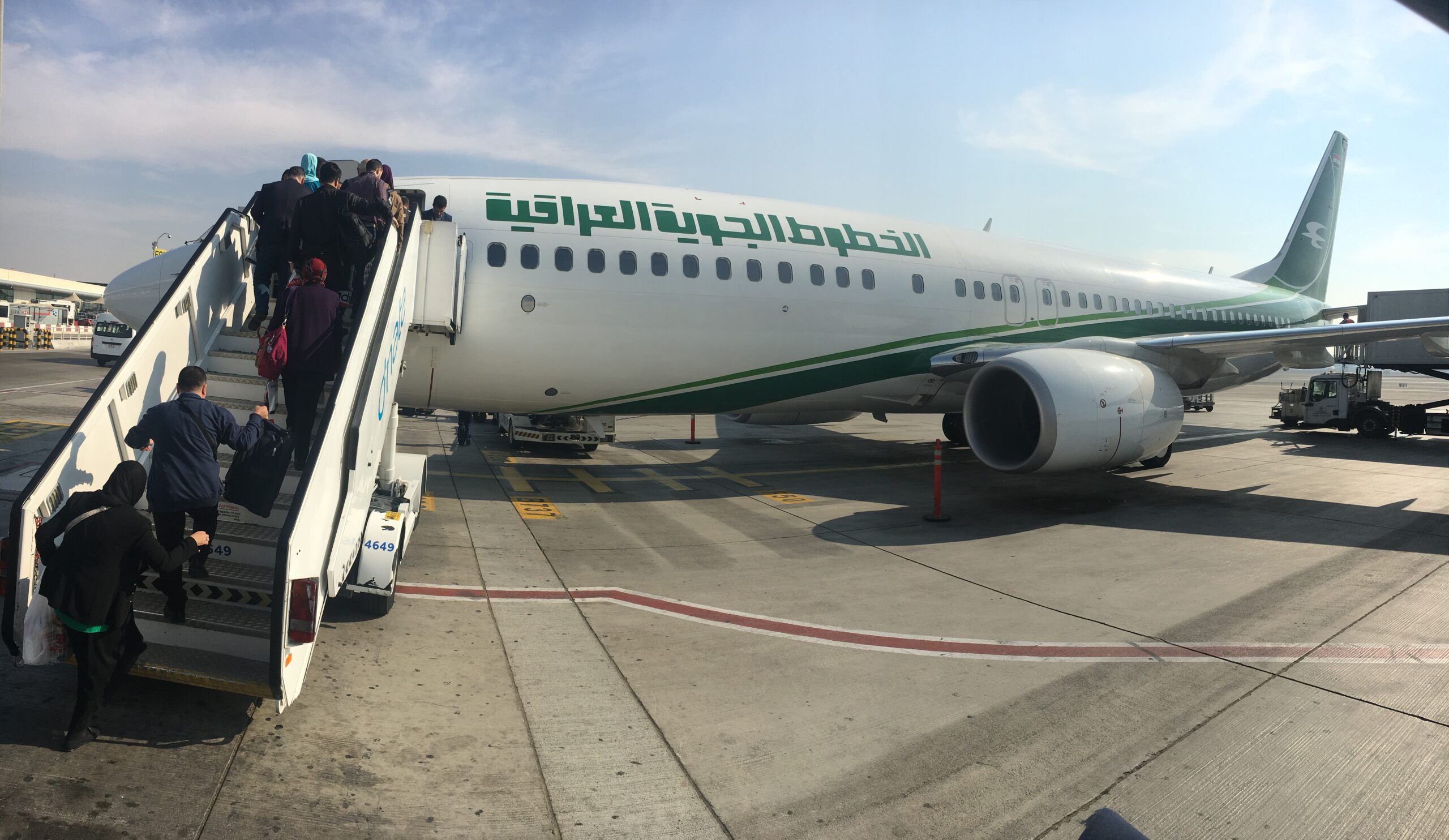My first-ever trip off the beaten track was to Beirut in 1994 to get a ride on one of MEA’s geriatric Boeing 707s, starting a love affair with the Arab world. One country in the region that I’d wanted to visit for many years was Iraq, and I found a tour operator in Baghdad offering an eight day tour, with flights to be arranged independently; Iraqi Airways, for the chance to sample an unusual air travel brand, was definitely part of my plan.
Iraqi Airways actually serve London Gatwick once a week but didn’t remotely line up with the tour itinerary so I surveyed other options. The airline have a fleet of 15 late-build Boeing 737-800s and six Canadair CRJ-900s, plus a handful of orphans – a sole Airbus A330 for busy local flights plus Guangzhou, a pair of ex-Malaysia 747-400s serving Beijing and Kuala Lumpur, a pair of A321s, and three A320s.
The range of destinations includes all the local staples – Istanbul, Beirut, Cairo, Amman (sometimes by 747, between long haul trips), Abu Dhabi, Delhi, and a handful of European ports. Flights don’t just originate in Baghdad – Najaf and Basra are also focus cities with route maps mostly duplicating that of the capital.
Booking
My tour started in Baghdad and ended in Basra so I booked two one ways – Dubai to Baghdad, and Basra to Beirut, marrying up with a BA open jaw ticket (London to Dubai, Beirut to London). The Iraqi Airways website is user-friendly with easy-to-access schedules which include details such as aircraft type. Prices for each flight were in the $150 range, and all major credit cards were accepted. There were no hiccups completing the booking and email confirmations arrived in my inbox promptly.
Along with the size and scope of Iraqi Airways operations in general, the ease of booking was reassuring to me; not only that the airline was reliable but that the country would prove to be safe and manageable for a tourist (which it did).
Check In
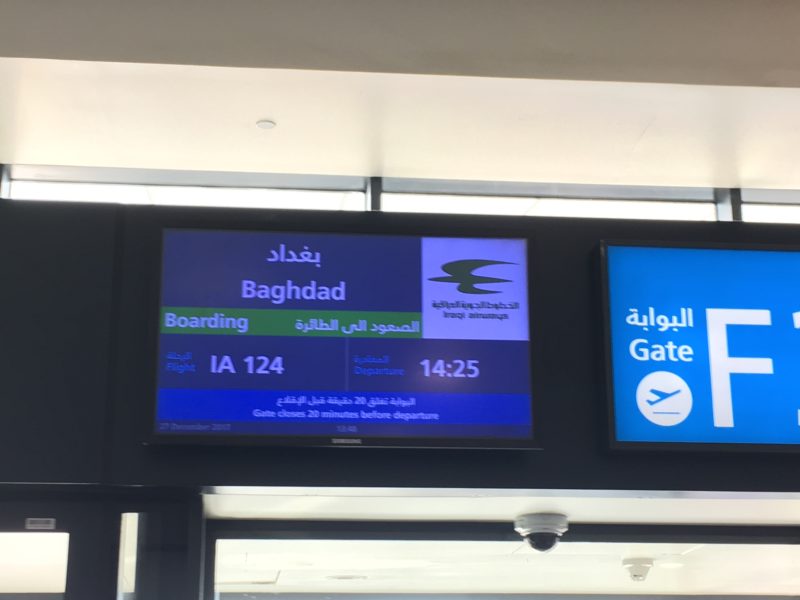
I was self-connecting in Dubai as Iraqi Airways, who operate from Terminal 2, are not an interline partner for British Airways, who arrive into Terminal 1. I claimed my checked bag after a pleasant overnight flight with the world’s favourite airline and went groundside.
Two grumbles about DXB. If I ran an airport that was a massive connecting hub and I wanted to grow tourism by encouraging more of them to break their journey in my city, I wouldn’t make entering the country such slow work. Equally, for a facility that is such a major crossroads, I was absolutely astonished to find there is no groundside transfer bus from Terminal 1 to Terminal 2. The only way to cover the distance is by taxi, 4.5 miles / 7 kilometres around the airfield perimeter at a cost of AED 42 / USD 12.
I remember catching an old Mahan Air 747-300 (an ex-UTA machine that still had maps of the French Caribbean on the bulkheads) to Tehran from Dubai’s Terminal 2 back in 2008, and the facility had been extremely austere and run down. The advent of flydubai, with a network of 95 destinations flown by 64 Boeing 737-800s, has resulted in the terminal being upgraded, with extra shops and snack options. Still bussing gates but that’s fine by me (proper aviating!).
Boarding
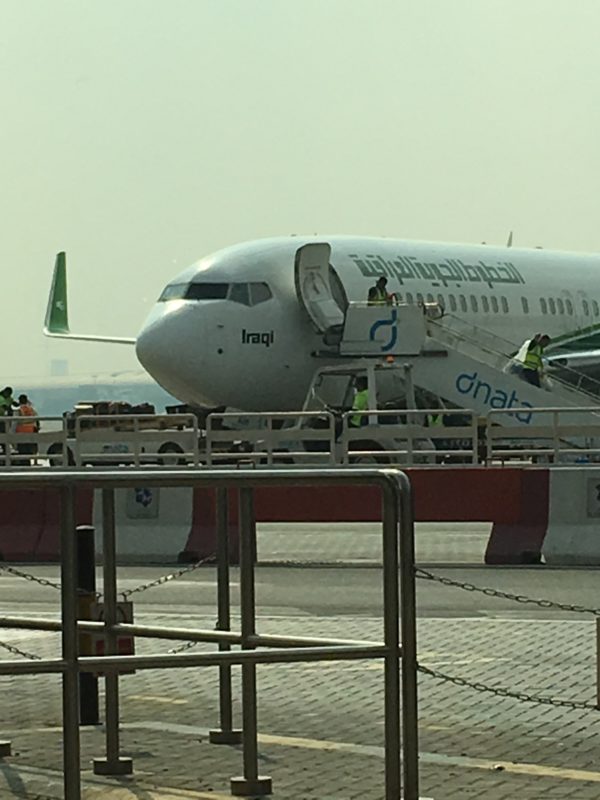
When our 737-800 arrived from Baghdad and commenced its one-hour turnaround, I had a chance to check the registration online to learn the provenance of the plane. Like most of Iraqi’s growing fleet of Boeings, it was a new-build ship delivered from Seattle to Baghdad only six months earlier. The fleet is currently at 15 with 15 more to come.
With the announcement of the flight, the passengers, who constituted a full load, lined up at the door and were bussed the very short distance to the foot of the steps, and boarding was completed in an orderly fashion.
Cabin and seat
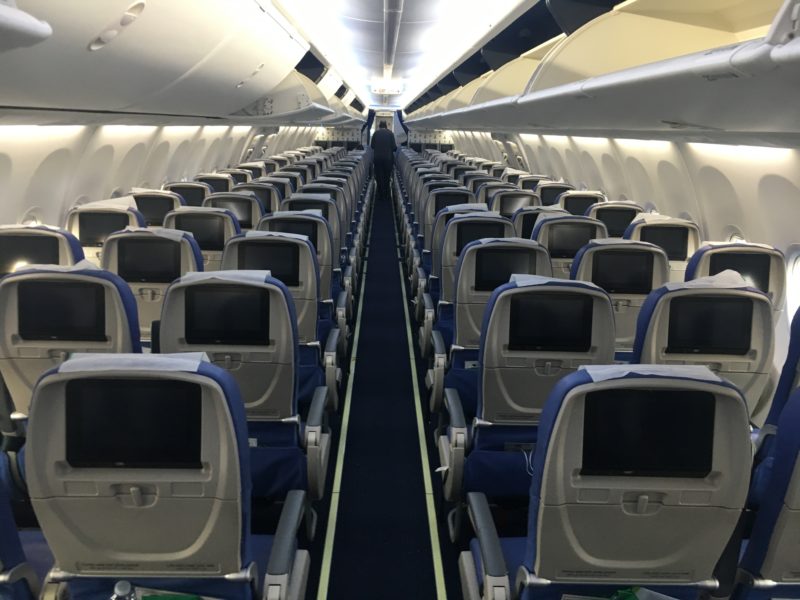
The clean and modern Boeing Sky Interior was fitted out with leather seats and scenes of Iraqi archeological treasures on the bulkheads. Seatback monitors with a mini headphone jack and a USB charging port were an unexpected feature, although content to watch was limited, with only one English language feature film, The Informant! starring Matt Damon. I was only interested in a nap after my short night on BA and to follow the flight map, which was high tech and full of detail as our flight progressed up the Persian Gulf, making landfall 35,000 feet over Basra and continuing up the backbone of Iraq, a journey I would make by minivan in reverse over the next eight days.
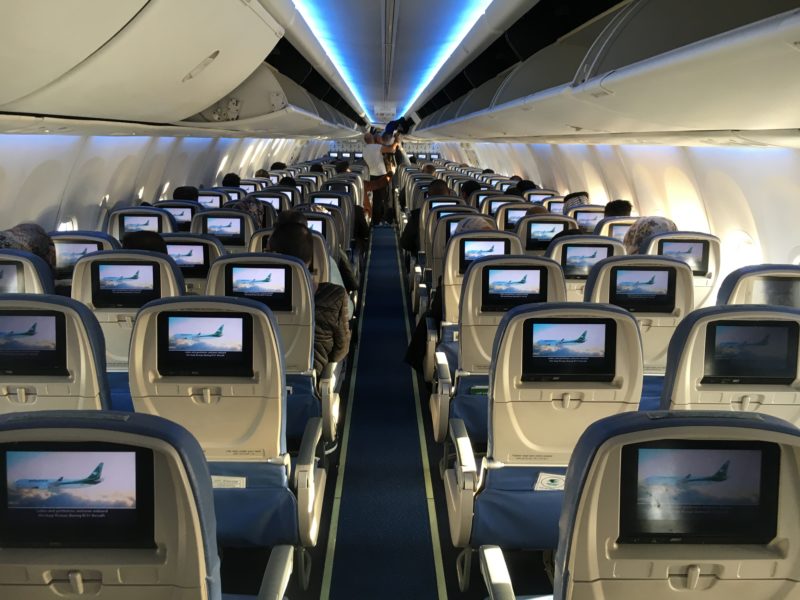
Food and beverage
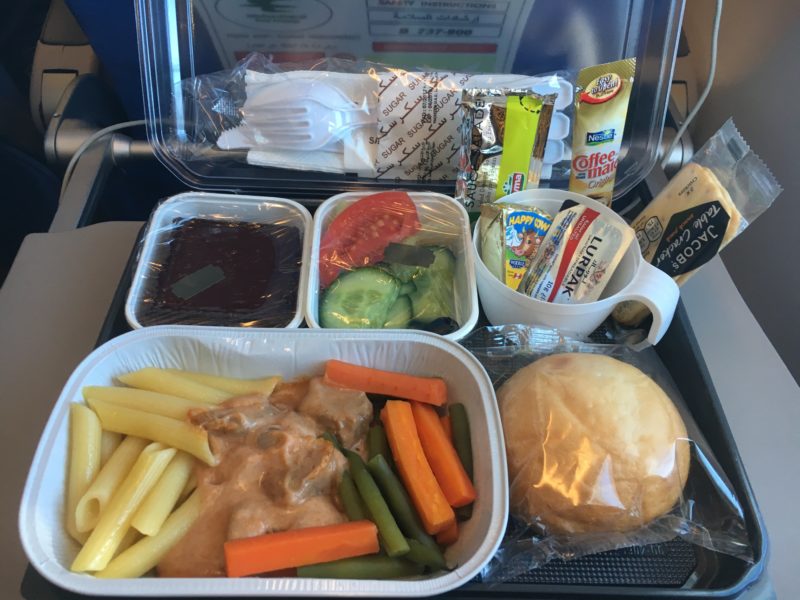
I had high hopes for the food; despite the new plane and IFE, the airline had something of an old school feel and a two-hour sector would hopefully be enough to enjoy a traditional airline meal with an Arabic twist. I was actually very happy with Iraqi’s offering, although what it lacked was a geographical identity, sporting a main dish of beef with flat noodles and cheese sauce. While tasty and filling, it was plain international.
Arrival
We began our descent at dusk, with eight million-strong Baghdad, the Arab world’s second biggest city after Cairo, spread across the horizon. Landing was smooth and we taxied off towards the terminal, which is pretty much the same as it was in the 1980s, preserved throughout sanction-bound 1990s without any flying at all, and very little in the first decade following the 2003 US/UK invasion that toppled leader Saddam Hussein, after whom the airport was once named (its airport code under his rule was SDM, now BGW).
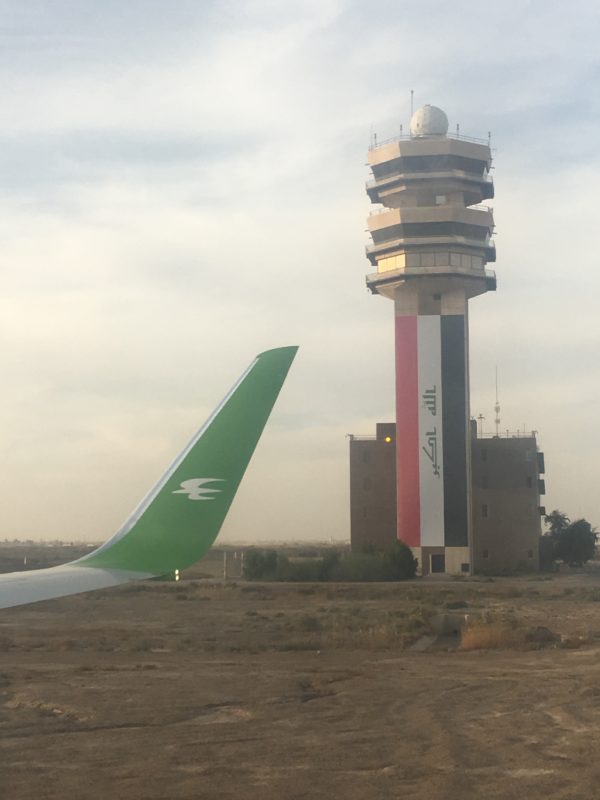
Although there were a number of Iraqi Airways 737s at jetbridges, and a few unoccupied jetbridges, we parked on stand but disembarked by stairs. The short distance to the terminal was covered by airside bus. Passport control was quick with no questions asked (like pretty much every visitor to Iraq, I had already acquired my visa from their embassy in London) and thus I proceeded to baggage claim, which involved a long wait and a very noisy clanking belt. An art installation made of brass on one wall hinted at the glory days of the 1970s.
Myself and the other member of our group who had taken this flight were intercepted by an official at baggage claim (as the only non-Iraqis on the plane, we were easy to spot) and were escorted to meet our friends who had had come in on Turkish Airlines or Pegasus hours earlier. With the group assembled, we were taken curbside where a fleet of SUVs shuttle backwards and forwards to a pick-up and drop-off station a few miles away from the terminal, where we met our tour guide and driver in whose delightful company we discovered Iraq.
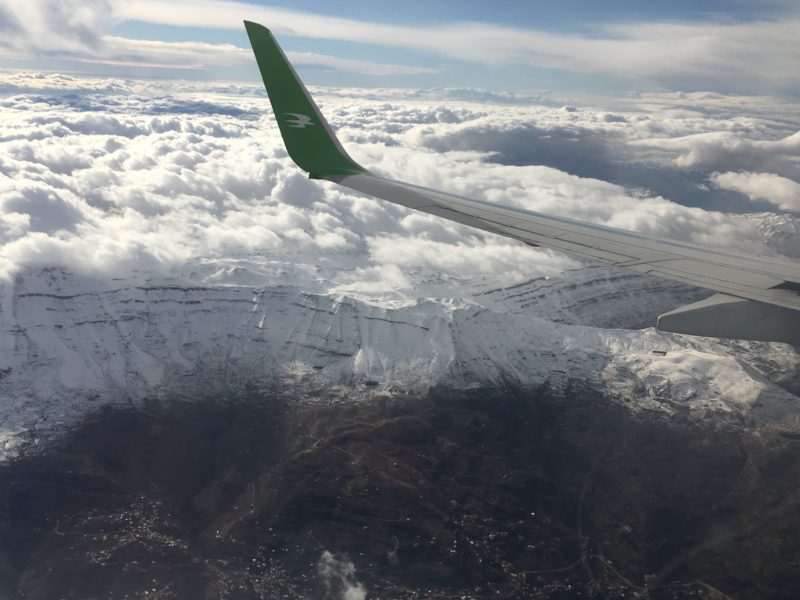
My flight out a week later was from Basra but under an identical security regime, with drop off and farewell at the dedicated area a few miles away outside the airport cordon. In detail: documents (passport, e-ticket print out) are checked and everything – checked bags and hand luggage – goes through a scanner, and the passenger goes through a metal detector with belts and coins etc on the tray. Having cleared this first layer of security, passengers are driven to the terminal in a shiny cream-coloured SUV. To enter the terminal, once again everything goes through an x-ray, and humans through a metal detector. At check in, bags go on the belt and are presumably hand-searched before loading onto the aircraft. Passengers and their hand luggage go through security to get to the departure area, and there is a final check at the gate itself.
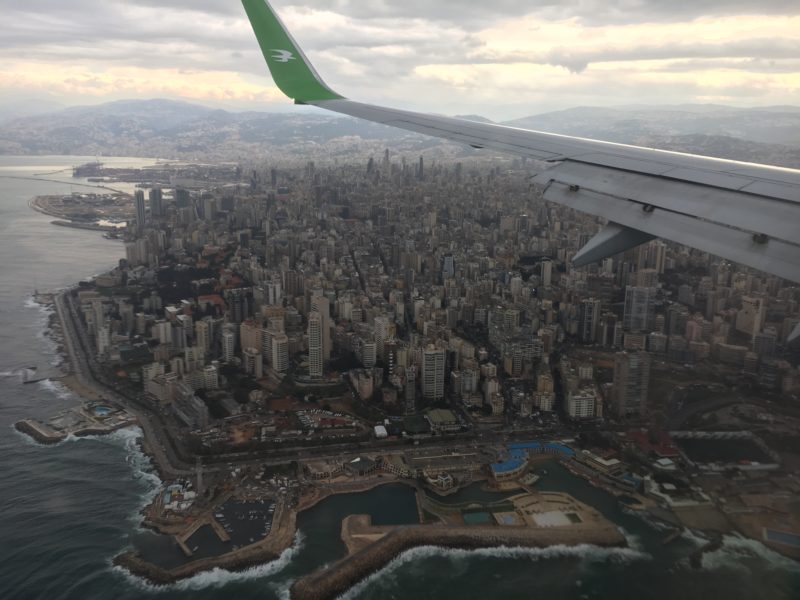
Overall impression
Iraqi Airways traces its history back to 1930, and in the 1970s and 1980s was a reputable carrier, with its vivid green Boeings a regular sight across Europe and Asia; the 747s strayed as far as Sao Paolo. While the airline kept flying after Saddam Hussein invaded Iran in 1980, the country was on a downhill slide; after the invasion of Kuwait in 1990, sanctions caused Iraq to lose all air links to the outside world.
With the removal of Saddam Hussein from office after the 2003 invasion, sanctions were lifted but the country was too dangerous for visitors or commerce to take place, and the return of air travel was a sole Fokker F-28 operated by a South African outfit based in Amman, with a dramatic dive from 10,000 feet, spiralling down within the airfield boundary to avoid hostile fire.
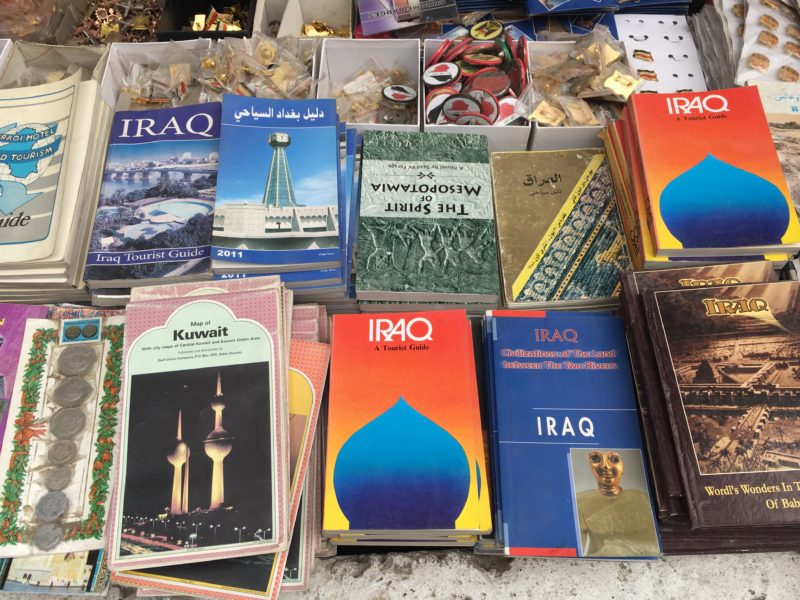
The gradual recovery of Iraqi Airways to its present size – a fleet of 30 aircraft and a solid portfolio of destinations – is a vital cog in the recovery of the nation it serves. The planes are new and fly on time. The corkscrew arrivals into Baghdad are a thing of the past. A decent onboard product with PTVs and a hot meal make for a very pleasant flight. Given the travails of Iraq, this is worthy of praise indeed. Hopefully as the country continues to return to stability, the airline will flourish– and vice versa!


